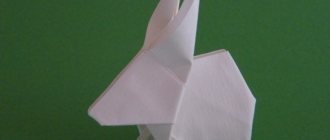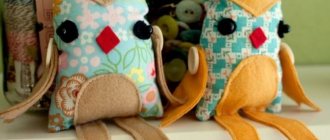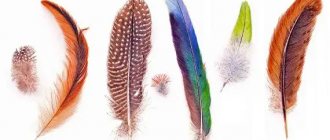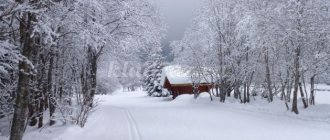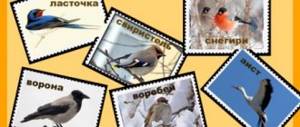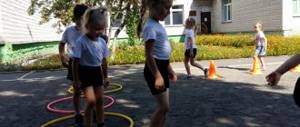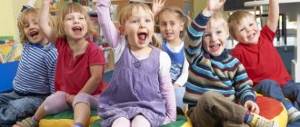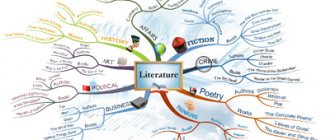Summary of GCD in the senior group. Bird feeders
Summary of educational activities for children of the senior group on the topic: “Bird feeders.”
Author: Irina Viktorovna Rodionova, teacher of kindergarten No. 169 “Forest Fairy Tale” ANO DO “Planet of Childhood “Lada”, Tolyatti Description: I offer a summary of the direct educational activities of children of senior preschool age. This material will be useful to kindergarten teachers. Topic: “Bird feeders” Purpose: To create conditions for children to become familiar with wintering birds and to make bird feeders from waste material. Objectives: Educational: To form children’s understanding of wintering birds: their appearance, nutrition, and habitat features in winter conditions. Developmental: To promote the development of interest in the animal world. Expand and activate children's speech reserve. Educational: Cultivate responsiveness, encourage the desire to care for birds. Integration of educational areas: cognitive development, speech development, artistic and aesthetic development, physical development. Preliminary work: Bird watching on a walk; Conversations: “Small titmouses”, “Our feathered friends”; Reading fiction: M. Gorky “Sparrow”, S. Marshak “Where did the sparrow have lunch?”, G. Skrebitsky “Titmouses have appeared”, V. Bianchi “It’s cold, there’s hunger in the forest”, A. Yashina “Feed the birds in winter”. Modeling on the theme: “Our feathered friends.” Learning proverbs about birds. Materials and equipment: audio recording of A. Vivaldi’s album “Winter”, presentation “Winter Forest”, presentation “Wintering Birds”, hoops of three colors, pictures - diagrams for differentiating between migratory, wintering and nomadic birds, pencils, scissors, waste material (juice boxes, kefir boxes), threads. Progress of the GCD: 1. Organizational moment: An audio recording of A. Vivaldi’s album “Winter” is played (the teacher turns on the presentation “Winter Forest”).
Educator: -What did you imagine when you listened to music? 2. Conversation on the topic: 1) posing a problem situation: “Why can’t you hear the birds singing?” Educator: -Guys, today I invite you to go to the winter forest. Look at the trees around: white caps of snow lie on the green paws of spruce and pine trees, and there is silence all around. I can't hear anything. Why so quiet? Birds are amazing creatures. -Tell me, please, what birds live in the forest in winter? — What birds live next to people in the city? -What birds come to us with the onset of winter? 3. Didactic game “Make no mistake” (Bruches of three colors are laid out on the table) Educator: -Birds are migratory, nomadic, and wintering. Arrange the birds: in a blue hoop - wintering birds, in a yellow hoop - migratory birds, in a green hoop - nomadic birds. 4. Didactic game “Guess who?” Educator: -Who can you tell about? -Cunning, dexterous, resourceful...(crow) -Yellow-breasted, dexterous...(tit) -Brave, cheerful...(sparrow) -Stubborn, motley...(woodpecker) -Predatory, big-headed, silent...(owl) -Red-breasted, lively...( bullfinch) -Bright, cheerful, friendly...(waxwings) 5. Rebus: Educator: -Rebus for boys: what wintering bird can imitate a dog’s bark, a person’s laughter, and even knows how to pronounce individual words. 3-P 4-O 1-B 6-A 1-B 2-O 5-N (crow) -Rebus for girls: which bird has its day. 6-A 3-N 2-I 1-C 5-C 4-I (tit) 6. Riddles: Educator: -Guess my riddles: 1) Black-winged, red-breasted and will find shelter in winter. He is not afraid of a cold, with the first snow right there! (Bullfinch) 2) What kind of bird is not afraid of frost, even though there is snow everywhere in its nest? (Crossbill) 3) I eat bugs and worms, I don’t fly away for the winter. Under the eaves, in a gray feather coat and in the cold, I am a hero. (Sparrow) 4) Who is wearing a bright red beret and a black satin jacket? He doesn’t look at me, he keeps knocking, knocking, knocking! (Woodpecker) 5) Northern guests peck rowan clusters, are the crests on their heads so elegant and bright? (Waxwings). 6) Sleeps during the day, flies at night, scares birds in the forest? (Owl) -Why are birds afraid of an owl? -What helps an owl hunt at night? 7. Game “The fourth odd one”: Educator: - Name what is odd here: tit, starling, magpie, pigeon; woodpecker, tit, sparrow, rooster; magpie, tit, bullfinch, sparrow; sparrow, tit, crow, owl. 8. Proverbs: Educator: -What proverbs about birds do you know? “A nightingale and a crow live in the forest, but they sing their songs in different ways,” “Wherever a bird flies, it knows its nest,” “A big bird needs a big nest,” “Every swallow praises its nest,” “Every bird goes to its flies in a flock." 9. Physical education lesson: Outdoor game “Owl” (2 times). 10. Teacher’s story on the topic: “Who eats what?” Teacher: -Guys, how can we help our feathered friends? -Tell me, what do birds eat in the summer? (insects) -And in winter? -Is it difficult for them? — Of course, it’s hard for birds in winter. It is especially difficult to find food during snowfalls, blizzards and severe frosts. In such weather, birds often go hungry and even die from starvation, and therefore approach people's homes. You and I must help our feathered friends survive the winter. Seeds of various plants are suitable for feeding birds: hemp, sunflower, melon. pumpkin, watermelon, many weeds. But only sparrows and buntings peck oats and millet. Tits are very fond of pieces of unsalted lard. 11. Finger gymnastics: Teacher: - Guys, we need to stretch our fingers. I decided to count the crows: (Children alternately hit fist on fist and One, two, three, four, five. palm on palm) Six is a crow on a pole, Seven is a crow on a pipe, Eight is sitting on a poster, Nine is feeding the crows... Well and ten is a jackdaw. That's the end of the counting! (Clench and unclench fingers) 12. Construction from waste material (juice boxes, kefir)
Educator: -You have boxes on your table. We will use them to make feeders. -What are threads for? (to tie a loop). -Handle scissors carefully! -Why do you need to cut a hole? (so that the birds get inside the feeder). 12.Result: Educator: -Well done! Everyone did it. Look how many feeders there are. Now we will go for a walk and hang our feeders. During a walk, a child reads T. Kulakova’s poem “Feeder.” Birds flew into our yard in winter, The birds started talking to us. The sparrow chirped, looked for grains, the crow croaked, the dove cooed, the tit tinkled, and the bullfinch whistled, and the waxwing branch also sang a song. Our poor birds are hungry in winter, there are few grains, crumbs, it is difficult to feed themselves. We made a feeder. They attached it to a birch tree so that wintering birds could survive the winter easier.
We recommend watching:
Summary of GCD on artistic creativity for children of the senior group. Summary of GCD in the senior group. Traveling into space Leisure summary for older children. A walk in the winter forest Notes of GCD for the older group. Travel game
Similar articles:
A story about a sparrow, grades 1-2
A story about a crow, grades 1-2. The world
Master class with parents and children of the senior group on origami “Wintering Birds”
Master class with parents and children of the senior group on origami
"Wintering Birds"
Purpose of the master class:
introduce children and parents to the origami technique.
Tasks:
— Teach children and parents how to make birds using the origami technique;
— Create a need to acquire new knowledge;
— Create a favorable atmosphere for informal communication between children and parents who are passionate about a common cause;
— Develop aesthetic taste, sensory experience, creative abilities;
— Cultivate responsiveness and friendliness;
— Expand your horizons, activate your child’s vocabulary;
— Cultivate a love for birds, a desire to help them in difficult conditions.
Preliminary work:
1. Observing wintering birds on a walk.
2. Creation of a subject application “Bird Feeder”.
3. Reading the story by G. Skrebitsky “Long-tailed Robbers”, the poem by M. Glazkov “Feed the Birds”.
4. Conversation about wintering birds.
5. Conversation with parents to identify those willing to participate in the master class.
5. View illustrations of birds.
6. Participation of parents together with children in hanging feeders in the group area.
Demo material:
1. Pictures depicting wintering birds (titmouse, sparrow, bullfinch).
2. Feeder
Handout:
1. Squares of two-color paper (black and red, blue and yellow, brown) (10x10);
2. Scissors.
3.Cloth napkins, oilcloths, glue stands, glue brushes, PVA glue.
Progress of the master class
Introductory part:
Educator: – Hello, dear parents. We are glad to see you and invite you and your children to make birds that stay the winter with people and bring good luck and happiness to your families on their wings, and making birds together will bring you closer to your child.
Educator: Listen to the poem:
Feed the birds in winter, Let flocks flock to you from all over, like home, on your porch. Their food is not rich, they only need one handful, one handful - and they won’t be afraid of winter. How many of them die?
It’s hard to count, it’s hard to see!
But in our heart there is
And it’s warm for them. How can we forget: They could have flown away, but stayed to spend the winter
Together with people.
- This poem, guys, is a continuation of our last lesson. What did we do with you? Children's answers.
- Why, guys, do people make feeders? (to feed the birds)
- Don’t birds fly south? (only migrating ones fly away)
- And who stays for the winter? (wintering birds - sparrow, tit, bullfinch, crow, magpie ? (shows pictures of birds)
— What do they eat, where do they find food? (seeds, tree buds; insects and insect larvae, taking them out from under the bark of trees.)
- And why? (because winter is a very difficult time for birds. After the thaw, the branches become covered with an icy crust, and heavy snowfall hides everything under the snow. Birds cannot find food under the snow. A hungry bird suffers greatly from the cold. We need to support the birds)
- What will they eat? (suitable for food are oats, millet, seeds,
bread crumbs) (demonstration of seeds and grains)
- That's right, guys. Do you want me to tell you a secret what kind of bird it eats?
(The teacher says that sparrows feed on grains and crumbs.
Tits feed on grains and crumbs; their favorite delicacy is lard.
Bullfinches eat seeds, berries, and love to peck rowan berries. Crows feed on scraps and leftover food.)
Educator:
Let's now invite the wonderful birds we make with our own hands to our feeders, together with our parents!
Notice what kind of geometric shapes lie on the table in front of you? (Children's answers).
- In fact, these are not simple squares, they are magical! Why magical? But here’s the secret: now in our hands the magic squares will turn into bullfinches, titmice and sparrows that will fly to our feeder.
Step by step explanation.
1. Take a square of two-color paper or two squares of colored paper, folded with the colored side facing up.
2. Fold the square diagonally.
3. Fold the resulting triangle in half and straighten it.
4. Turn the top down.
5. Fold the top corner up, catching one layer of paper (or two if it's single-sided colored paper).
6.Expand the figure, bend it in half.
7. On a small triangle, bend the corner inward so that it is visible.
8. Raise the wing corners on both sides.
9. The tail can be done in three ways.
1 way:
make a rectangular cut in part of the tail.
Method 2:
make a cut along the tail and remove the parts located below the cut inside the figure.
3 way:
make a cut along the tail and bend the parts located below the cut into the figure with an offset, forming the legs.
10. Draw the eyes.
Finger gymnastics “Feeder” (in the middle of practical activity, performed together with parents)
The guys sawed and sawed planks. And together they made a bird feeder. We will pour treats into it for the birds: A few seeds and leftover cookies, Dried fruits and bread crumbs, and hang a little lard on the branches. And in order to look at the birds' dinner, let's step back a little and not make any noise.
sawing movements with the edge of the palm, hitting the palm with the fist, rubbing the pads of the fingers,
bending the fingers,
bringing the “glasses” to the eyes
“
Fingers are walking,” bring the index finger to the lips.
Educator:
Well done!
How well everyone did the task. what beautiful birds you have turned out to be. ( The teacher praises the children and parents, notes those who made additions to their work).
- Why are they lying on your tables? Let's tell them all together:
- One, two, three, fly to the feeder
(everyone comes up to the feeder and puts their birds in it).
Physical exercise “Pigeons and Sparrows”
(performed by children)
Among the white doves Children walk in a circle, pretending to be pigeons;
A nimble sparrow jumps. in the center there is one child - he jumps like a sparrow.
Sparrow - bird , (Children stand facing in a circle, walk at a side step.
Gray shirt. "Sparrow" tries to "fly" out of the circle;
Respond, sparrow, the “doves”, holding hands, do not let him in.)
Fly out, don't be shy.
Thank you for participating, see you later!
How to make an original bird feeder from wood with your own hands - drawings, dimensions
Bird feeders have long become something more than just a device for feeding them. We admit that we not only want to make life easier for birds, but also to observe the behavior of wonderful birds, decorate our yard, realize ourselves in front of others and teach our children to love this world. If at the same time our wards help in protecting the garden from pests, it will turn out very well.
Bird feeders: what should they be?
When starting to make a feeder, it is useful to remember Exupery’s remark: we are responsible for those we have tamed.
In other words, having accustomed the birds to easy food production, we are obliged to think about them all winter.
Otherwise, they will experience big problems, losing food overnight, and may even die. Now we list a number of characteristics that a poultry canteen must meet:
the bird table must have sides that will prevent the wind from blowing away the food; the craft should not have sharp edges that could injure birds’ legs; a roof over the table will protect food from rain and snow; the feeder should be, if possible, inaccessible to cats; the holes in the walls of the craft must be of sufficient size so that the birds are not afraid of closed spaces; the product must be moisture resistant in order to last at least one season; the craft should not sway too much in the wind, that is, it is better to weigh it down with a piece of linoleum or pebbles.
The birds won't like this feeder.
Bird feeders: what are they?
There are so many people who want to make an exclusive table for birds that they have created an innumerable number of hand-made works. Obviously, everyone's preferences and capabilities are different. We intend to offer you a range of different products with a description of their features and designs. Of course, we will also discuss the wishes of the birds themselves. Putting everything together, you will have the opportunity to compose your own “symphony” called “bird feeder”.
Made of wood - most options
The picture shows feeders made from planks. Depending on preferences and availability of material, you can choose one or another design. The very first option has a twist: a gap on the side bar for water to drain. Any product will last longer if it is treated with impregnation, painted and varnished.
These products are a little more complicated - they are all made of bars and slats. This material allows you to make quite interesting and exclusive options. Pieces of roofing felt on the roof will significantly increase the durability of the craft. The bars and slats can be secured with small nails or glue.
Using tree branches will bring your craft closer to nature. The product can be quite simple and unusual. The use of impregnation and varnish is also advisable in this case.
Feeders made from birch branches look very interesting. Given such material, I would choose this option. Various roof construction methods are possible. Birch bark already has protective functions, but varnish will not hurt.
The photo shows several feeders for mounting on a wall or to a tree trunk. They all have a back plate with a hole for fastening. You can independently make options of varying complexity. The glass jar feeder is very simple and easy to use.
The photo shows surprisingly simple and original wood structures. It’s quite possible to make such feeders yourself. Treatment with protective impregnation did them good.
Carved products are fraught with considerable possibilities. However, in this case it is difficult to do without a jigsaw. A piece of galvanized steel on the roof is correct. Treatment with a blowtorch will give the product a special color. It is simply necessary to protect a product on which a lot of time has been spent from moisture.
The images above show a selection of products made by professionals. All parts of the feeders were first processed and painted, and then assembled into a single structure. As a result, we have impeccable appearance and durability. Nothing prevents you from repeating the same thing!
The photo shows feeders that will decorate a mansion of any level with their presence. Probably, such products are made by specialists in a workshop. I am sure that if you set a goal, it is quite possible to repeat the elite version yourself.
In the photo above we have selected the most interesting ideas for wood feeders. They differ in materials and design. Moreover, it is quite possible to make such products yourself.
Made from plywood – its features and capabilities
Here are several designs of plywood feeders. There are quite a lot of products made using this technology. The parts of such feeders are cut out on a machine and sold in stores in the form of sets. Crafts are assembled easily and quickly. A set from the store is interesting and useful to process and paint to your taste.
These products are made in a workshop from thick plywood. The designs are assembled from simple parts and can be easily replicated yourself if you have a jigsaw. Clean plywood clearly requires coating and decoration.
It is much easier to make a plywood feeder using bars and slats. In this case, you can do without a jigsaw. The designs shown in the picture are different, but simple.
Plywood feeders using wood are quite popular. We demonstrate several more possible options. Simplicity of execution cannot create barriers to exclusive options if creative people get down to business.
The picture above shows evidence of the effectiveness of using paints in making a feeder. In the hands of craftsmen, fairly simple products can easily turn into fabulous attributes. In this case, desire is more important than the inclinations of an artist.
Especially for those who want to make a feeder from plywood and blocks, we have prepared product drawings. All parts are numbered for convenience. To assemble the feeder you will need 4mm thick plywood, a block with a cross section of 20x20mm and wood screws.
Here is a drawing of the parts of the feeder. The number of the latter is given in the table. The cross-section of the 20X20 bar is not shown in the drawing.
From bottles - simple and reliable
Very often bird feeders are made from plastic bottles. This is due to the availability and durability of available materials and ease of manufacture. Transparent plastic bottles allow you to easily observe the behavior of birds.
The sharp edges of the plastic must be treated with electrical tape or a PVC tube cut along the length. Then the birds will not injure their legs and plumage. Light bottle feeders should be weighted with pieces of linoleum or pebbles to prevent them from swaying in the wind. The image above shows the simplest options. Read about how to paint plastic bottles in a special article.
Containers made from automobile fluids make it possible to obtain more reliable and voluminous structures. Unfortunately, they are not transparent. In feeders made from any plastic containers, small holes should be made in the bottom to allow water to drain.
Five-liter eggplants can be decorated beyond recognition. Burlap, twine, washcloth and small twigs will do. To prevent beauty from fading quickly, it is necessary to use moisture-resistant materials and glue.
As you can see, there are plenty of options for decorating feeders made from five-liter bottles. Show your imagination and make it your own and unique. Don't forget about the reliability of the design.
In the photo above there are several more typical techniques for using plastic bottles:
In the first picture, two holes were made in the bottle opposite each other, closer to the neck. A stick was inserted into the holes - a stick. A hole for food was made just below the perch. It should have optimal dimensions: the seeds do not spill, but are accessible to the bird. Then they poured in the food, turned the container upside down and secured it to the tree. In the next image, the role of dispensers and shelves is played by the two upper parts of the bottles, tightly inserted with their necks into the holes on the sides of the main bottle. The lower edges of the specified parts are bent and turned inward so that the birds do not injure their paws. The picture on the left below shows the possibilities of using paints. The simple, tasteful design brings the technical transparency of plastic to life. The presence of wooden spoons helps to call the birds for dinner. They are simply threaded through the holes in the bottle. It is better to place the spoons at an angle so that two birds can eat at once. The holes for food above the spoon should not be too large so that the food does not spill out all at once.
Made from cardboard and bags - cheap and cheerful
Bird feeders made of cardboard and cardboard boxes are the most unreliable. But you can make a large feeder and decorate it as you wish. You can increase the service life of a cardboard bird canteen by covering it with tape or film.
We recommend: Garage made of profile pipes
Dairy and juice bags are a good way to make feeders. They cost nothing and have good moisture resistance. Of course, bottles are more durable, but bags are easier to work with. You have several options for execution.
Made and written with your own hands. Author: Miroshnikov A.P.
We decided to make a fun and simple feeder from a 2 liter juice carton. The idea came up to feed the birds on a makeshift bus. The master class on assembling the craft is quite simple:
Use a marker to mark the windows of the bus. We leave a gap of 2 cm between the windows, 1.5 cm above them, and 3 cm below them. We cut out the windows with a sharp knife. On the top plane we make four holes for attaching pendants. We insert two pieces of soft wire into the holes on the roof. We tie the ends of the wire with a knot to secure the latter. We take four caps from five-liter bottles, make holes in them and screw them to the body of the craft with screws. For reliable fixation and protection from sharp protrusions of screws from the inside of the craft, you can add caps from ordinary plastic bottles. Then we screw the screws into them through the wall of the bus. In the same way, we screw another white cover in front - the headlight. To ensure that the headlights are the same, we screw the same screw into the standard cover on the box.
Unusual – bunker, transparent, designer, funny
Of particular interest to us are bunker feeders, which provide automatic feed supply as it is consumed.
This way, bird food is not blown away by the wind, and we do not have to constantly monitor the availability of grain. The design of such a feeder can be very different, but the essence is the same: through a hole of a certain size, food pours in from above and replenishes the bird’s table. In the above examples, the dispenser is:
gap between two glasses; narrow neck of a glass bottle; holes at the bottom of the plastic bottle.
We have already considered similar options in the description of feeders made from plastic bottles. Based on these principles, you can certainly come up with something new.
Feeders using plexiglass look elegant. Birds and food are clearly visible. The design approach makes you want to repeat a successful experiment.
I don't want to throw away the rest of the tea set. Here are four options for using dishes as a feeder. The moisture resistance and appearance of the material are beyond doubt. Securing a cup or teapot in the garden is not difficult.
Particularly persistent and talented home-made people create funny feeders - jokes. We must be determined to repeat the best examples. It’s especially nice to compose something of your own.
To begin with, you can try a simpler option made from plastic bottles. Much depends on the materials you have at hand. The above examples are quite subject to female hands.
Here are four options for a “male” cool wooden feeder. The design of the crafts is quite obvious. Repeating the proposed ideas is a very real task.
Here are images of several more options for unusual bird feeders. The main idea is obvious: don't be afraid to experiment. It’s easier not to torment yourself with searching for exactly the same materials, but to use existing ones.
Let's make a feeder together - a snowman from a plastic bottle
Made and written with your own hands.
Of course, I want to make a bird feeder simpler and more interesting. It seems to us that a snowman with gifts from Santa Claus for the birds is a suitable option. The master class for making crafts is as follows:
On one side of the bottle we mark the snowman's mouth with a marker. Now this wall will be the face. We cut out the outlines of the mouth according to the markings. Bend the resulting tongue down 90 degrees. On the side we mark the ear in the form of an inclined oval, narrowed at the bottom. Cut a hole simulating an ear. Place the resulting piece of plastic on the other side and outline it with a marker. Cut out the second ear. Mark a large rectangular hole at the back of the head and cut it out. The result was a blank, as in the photo above. Paint the snowman's cap the same blue as the bottle cap. Paint the bottom of the eggplant with white paint. We paint the tongue with red paint. We put a plastic corrugated tube with a diameter of 16mm on the edges of all holes. In an electrical goods store, 2m of such pipe will cost absolutely nothing. We first cut the tube along its entire length. To weight the container we use linoleum. Place the container on it and trace it with a marker. It is better to cut out two such parts. We prepare plugs, screws, a sealant cover and a stick in accordance with the picture. We make holes in the corks for screws. We make a hole in the red cork for the stick. We make two holes to install the nose stick. We punch one at the place of the nose, the other at the back of the head. We insert a stick into them. We first put the red plug on it, and then the sealant cover. The result is a snowman's nose. We collect the eyes from small white and large blue caps. We screw them into place with self-tapping screws. From the inside, we screw two more covers onto the protruding screws to securely fasten the eyes and protect against sharp screws. All is ready!
Master class on making a classic feeder
Made and written with your own hands.
At school, my youngest son was encouraged to make a bird feeder. The following materials were found:
painted galvanized corner 50x50mm; wooden slats with a cross section of 20x40mm; a piece of plywood 4mm thick.
From which it was decided to compose my work. The sequence of the master class is as follows:
two rectangles measuring 22x34cm were cut out of plywood for the ceiling and floor and two more rectangles measuring 23x37cm for the roof; Four supports 18 cm long were cut out of the slats; two sides measuring 23cm and two sides measuring 37cm were cut out of the corner; all wooden and plywood parts were painted in two layers; all parts were fastened with self-tapping screws, as in the photo; The result is a bright and reliable bird feeder.
Cereal biscuits for birds
Sometimes you can do without creating a feeder to help the birds. You can hang special bird cookies on tree branches. Note that bird cookies made from grains look so tempting that I would eat them myself.
The first way to make a delicacy is as follows:
prepare molds for making cookies; place pieces of twine in the molds that will serve as pendants; dissolve the gelatin packet in warm water; pour grain feed into the prepared solution; pour the mixture into the prepared molds; place the food in the refrigerator to harden; We hang the finished cookies on tree branches: accessible to our eyes and out of reach of cats.
In the absence of forms, beautiful food for birds can be made in another way:
cut out figures of various shapes from cardboard; we make holes in the cardboard blanks, thread twine through them and tie rings for fastening on the tree; to attach the food to the cardboard, we prepare special glue, which consists of an egg, a spoonful of honey, 2 tablespoons of oatmeal and flour; mix the mixture and leave to mature for half an hour; When the glue is ready, lubricate the cardboards with it and roll the latter in bird food; send the semi-finished product to the refrigerator to harden; When the cookies are ready, we hang them on the tree and go to the window to observe.
Bird food: “what is good and what is bad”?
Take a close look at the birds that have remained to spend the winter in our area. The hope was frozen in their eyes that we would not give them an “expired product” or harmful food for them, from which the birds would suffer. Let's remember what we cannot treat our charges to, what should never be included in their diet:
salted and fried seeds; cream puffs and cake; fresh white bread; Rye bread; nuts; chips; cereals; leftover bananas and other citrus fruits; fresh fruits.
Fortunately, the range of possibilities is much wider. Birds can be offered:
bread crumbs; sunflower, pumpkin and watermelon seeds; cereals: oats, wheat, millet, barley; rice, buckwheat; unsalted lard especially for tits; viburnum and rowan, maple and ash seeds especially for bullfinches.
Eggshells, coarse sand, and crushed chalk will serve as seasoning for birds' dinner, especially during the nest-building period. Thus, we know almost everything about bird feeders and bird food. By the way, observing the behavior of birds in spring and summer is no less fascinating than in winter. We wish you good luck and offer a video to help.
Source: SamoDelino.ru
